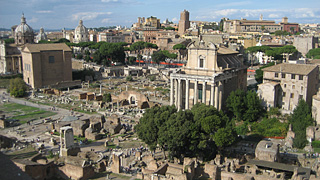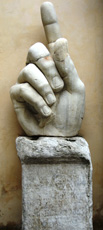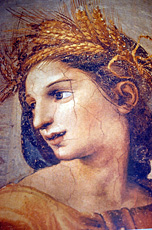On Foot: Walking Tours in Rome
For ease of reference I have broadly given the walks a theme, my aim being to include different "types" of places in each walk. These are 3 hour itineraries.
From Rome's beginnings to Trastevere:
Starting from the Capitoline hill we walk in the footsteps of Rome's mythical founders Romulus and Remus. Making our way over towards the Circus Maximus, once the busy track for the chariot races, and up onto the tranquility of the Aventine hill. A sleepy collection of medieval churches appears strangely detached from the bustle of the city which hums below along the river Tiber. We finish in the area known as Trastevere walking through colorful cobbled streets, where the local inhabitants feel the most Roman of all Romans, tackling their daily chores with an almost fatalistic acceptance, which comes from their deep understanding that Rome is not just home but a superb backdrop to their "dramatic" lives.
Imperial Rome:
We enter Rome's vast area of archeological remains starting with the Palatine hill, once the home of the city's ruling elite and the site of Rome's first murder. We walk down through the Forum, once the political heart of the world, with all the monumental, ceremonial and social grandeur this area was built to convey. After a leisurely stroll taking in part of the imperial forums, we end up going inside Rome's most famous landmark: the Colosseum.
The Capitoline Hill in more depth:
Once the home of Rome's most impressive temple dedicated to Jupiter, this hill has seen its fair share of transformations. We will start with the world's oldest museums, which house a superb collection of ancient bronzes and marble sculptures. Much like an onion, this hill consists of many layers, from the tabularium and ancient Roman insula, to a medieval church and the piazza del Campidoglio, now synonymous with the town hall. We end with the enormous white Victor Emmanuel monument, which is so often called the "wedding cake".
Renaissance Rome:
Starting with the Pantheon, Rome's most influential ancient building, we walk a short distance to see the courtyard of Palazzo della Cancelleria, the façade of Palazzo Farnese and a section of the picturesque Via Giulia. Finally we cross the Tiber at Ponte Sisto to end up in the opulent rooms of the Villa Farnesina, where you truly sense the interweaving of ambition, wealth and rivalry that dominated Rome's ruling families in the 16th century. Understanding the "Renaissance" through the eyes of an architect, a cardinal, a pope, a banker, and an artist, builds up a picture as to what this remarkable period of optimism was all about.
Medieval Mysteries and The Rise of Christianity:
Starting in an ancient Roman house known as the Case Romane, once an early meeting place for Christians before Christianity was legalized, this walk traces its way through the decline of paganism and the steady growth of the church. We will visit the 9th century chapel of St Sylvester at the Dominican monastery of Santi Quattro and end up in the cloisters of San Giovanni Laterano after visiting Rome's Cathedral with its golden apse mosaics and impressive doors.
 Baroque Genius: Bernini, Borromini and Caravaggio
Baroque Genius: Bernini, Borromini and Caravaggio
Starting with the small church which houses Bernini's Saint Teresa in Ecstasy, we get a true sense of how theatrical Baroque art can be, before going on to have our convictions challenged by Borromini's deceptively simple San Carlino and to learn that this was a period of experimentation. From the top of the Quirinal hill, now the home to Italy's president, we descend to the famous Trevi fountain and head for the Jesuit church of Saint Ignatius. Here we see a new concept of space, one which gives us a glimpse of the eternal, before coming back down to earth with Caravaggio's intense paintings depicting Saint Matthew in the French church of San Luigi. We end with the famous Piazza Navona, with its unique combination of charm and splendor.